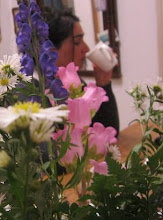Aboriginal Mapping
"all humans originate from aboriginal cultures. In all of us is some remnant of an ability to understand relationships of physical space to survival and the evolution of stable community life...In admiring the mapping of aboriginal cultures, the goal is not to copy others, but to rediscover in ourselves a genetic memory of ancient skills. This is no romantic quest. What we seek is inspiration from the best attributes of those who remain close to the land — rootedness, spirituality, and the ability to live in complex harmony with other life." Doug Aberley, “Eye Memory: The Inspiration of Aboriginal Mapping”
.jpg)
The Aboriginal Australians were able to navigate across their harsh and unforgiving land by memorizing and following the Songlines--an intricate series of song cycles that identified the landmarks that one needed to pass to get where one needed to go. These songs described how the features of the land were created and named during the Dreamtime, the timeless era when the giants, heroes and monsters that serve as totems for the Aboriginal tribes walked the earth. By singing the songs in the proper order, the Aborigines could walk across their nation's vast deserts and always know where they were.
"Aboriginal maps can only be properly read or understood by the initiated, since some of the information they contain is secret. This secrecy concerns the ways in which the map is linked to the whole body of knowledge that constitutes Aboriginal culture. For Aborigines, the acquisition of knowledge is a slow ritualized process of becoming initiated in the power-knowledge network, essentially a process open only to those who have passed through the earlier stages. By contrast, the Western knowledge system has the appearance of being open to all, in that nothing is secret. . . . In the Western tradition the way to imbue a claim with authority is to attempt to eradicate all signs of its local, contingent, social and individual production.""In the light of these considerations we should perhaps recognize that all maps, and indeed all representations, can be related to experience and instead of rating them in terms of accuracy or scienticity we should consider only their "workability" -- how successful they are in achieving the aims for which they were drawn. . . ." David Turnbull in Denis Wood, The Power of MapsThe Guldford Press. New York and London, 1992. p.40.
In my old blog, i was talking about Native American Mapping Traditions, here's a link to it.





2 comments:
that beautiful image is not an aboriginal map, but from the marshall islands. i've been kind of obsessed with these beautiful sculptures of sea currents for the last few years. take a peek -
http://inbetweennoise.blogspot.com/2006/10/sticks-and-seas.html
Not the map, nor the idea which comes from Bruce Chatwin "Songlines"
see
http://en.wikipedia.org/wiki/The_Songlines
Post a Comment